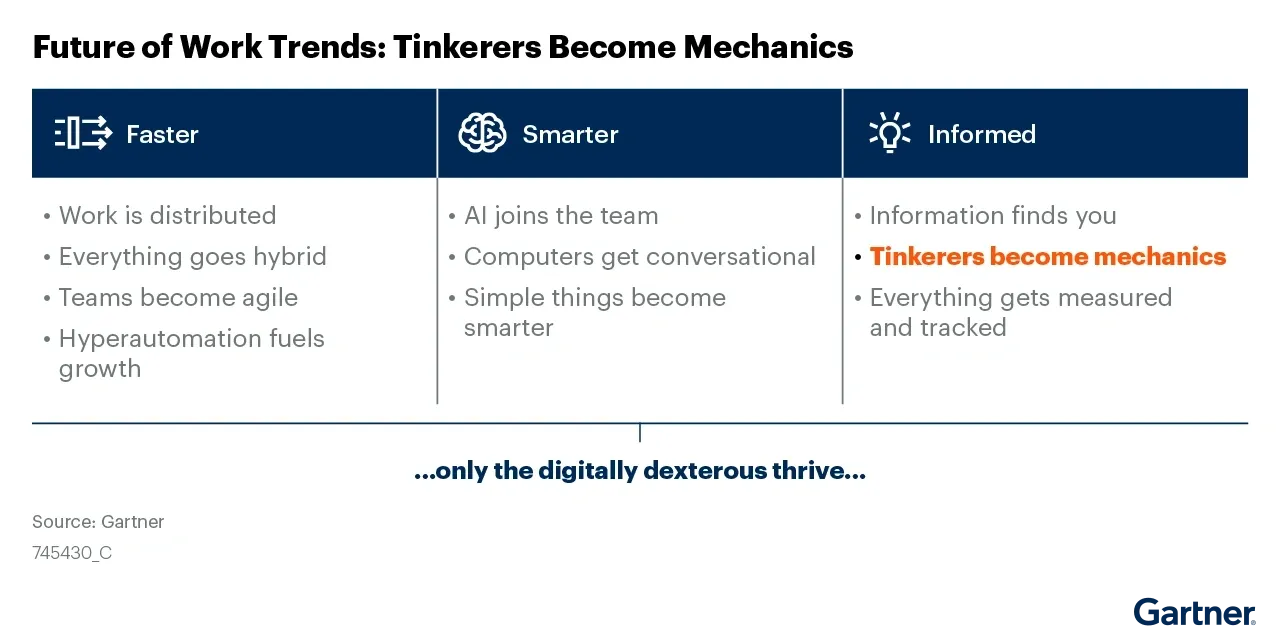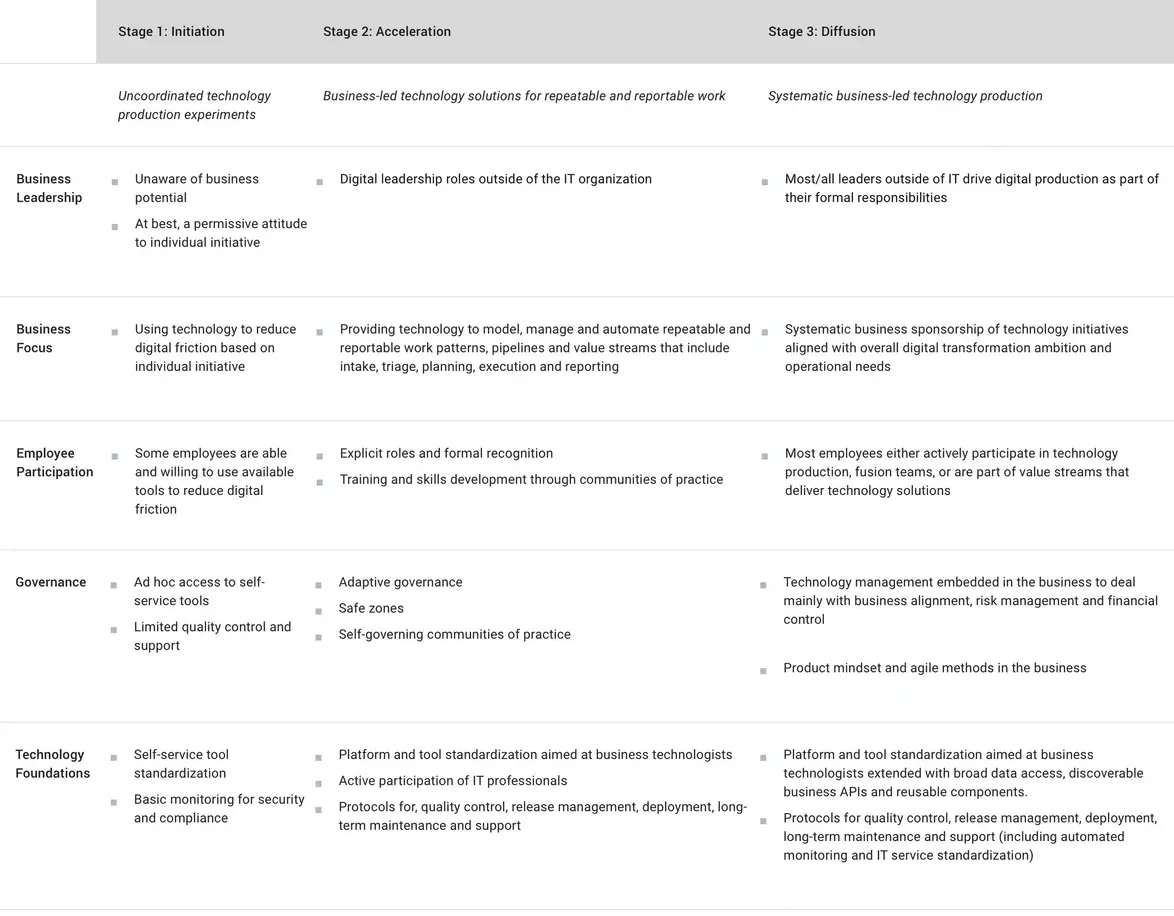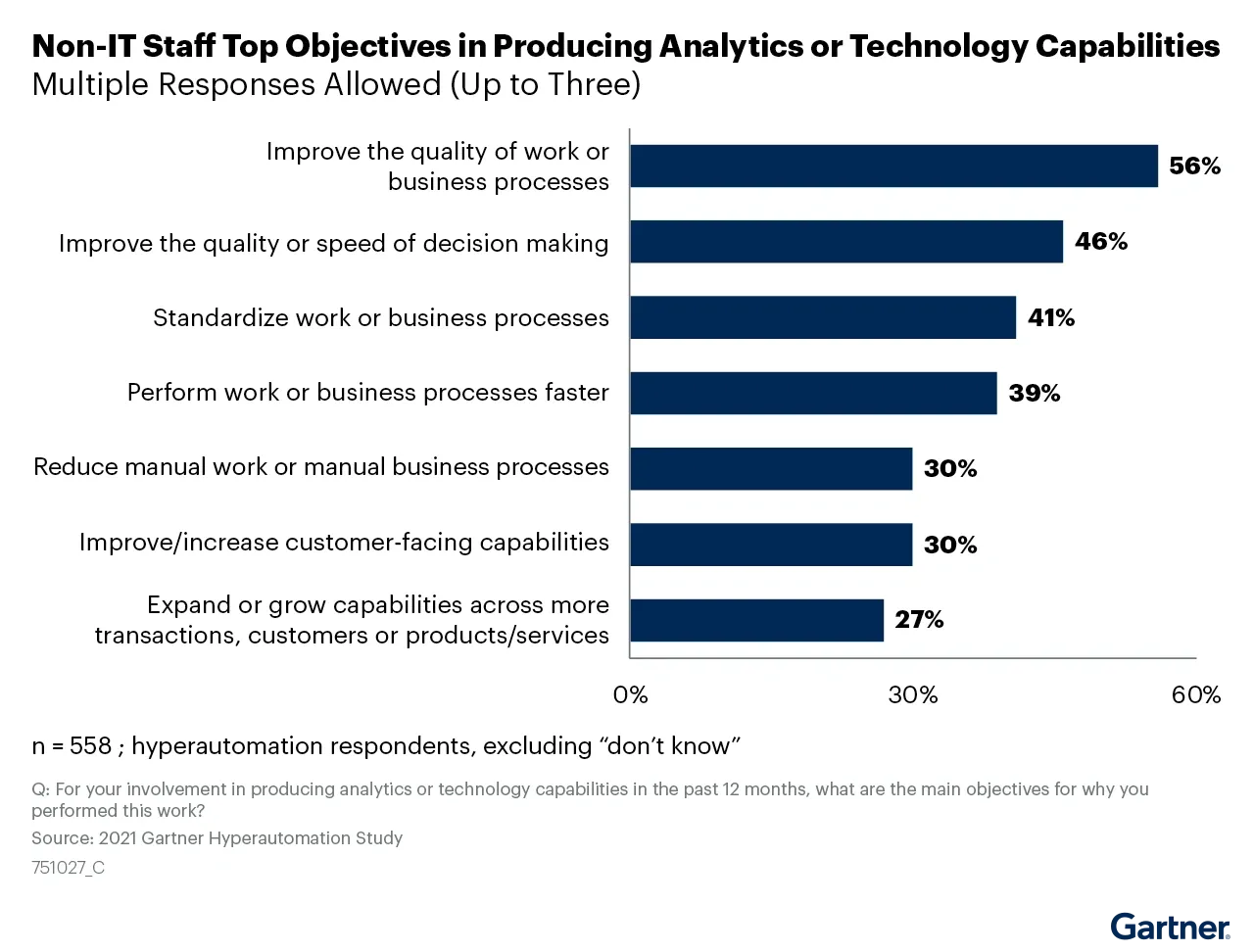Business-led technology delivery is an essential ingredient for accelerating and scaling digital transformation. To move from tactical experimentation to sustained, business-led democratized technology delivery, executive leaders must prepare to play a bigger technology leadership role.
OVERVIEW
Opportunities
- Business-led technology delivery offers an opportunity to reduce unnecessary effort when using technology (digital friction) by empowering employees to streamline efficient workflows and eliminate mundane and repetitive tasks.
- The demand for digital transformation and automation cannot be met by the IT organisation alone. By shifting more responsibility for technology production to parts of the business where there is both business and technology expertise, there is an opportunity to scale technology production in responsive, agile and innovative ways.
- Early targets for democratised delivery are common repeatable and reportable work patterns that include intake, triage, planning, execution and reporting. Where such work is not handled adequately with spreadsheets, and where business applications are not available, there is an opportunity for democratised technology delivery.
Recommendations
Executive leaders who want to implement sustained, business-led democratized technology delivery should:
- Embrace greater shared responsibility for technology solutions, including business ownership for some solutions in order to scale and amplify their business impact by developing technology management as a core business leadership competency.
- Identify and encourage employees proactively outside of IT willing and able to use technology in order to increase the enterprise’s capacity for business-led technology delivery. This includes providing access to technical experts and professionals; recognizing and rewarding their efforts, including through formal programs; and embedding technology responsibilities and product ownership in business leadership roles.
- Prioritize co-creation demands for business-led technology delivery by focusing on business activities that exhibit common work patterns, pipelines or value streams that include intake, triage, planning, execution and reporting.
- Boost workforce digital dexterity by expanding digital workplace programs to include digital delivery capabilities that allow the enterprise to scale business-led technology delivery.
- Establish fit-for-purpose protocols, systems and practices in collaboration with IT to systematize and manage democratized technology delivery. These protocols should address quality control, maintenance, support, production automation, guidance, prebuilt components, fusion teams and self-governing communities of practice (CoP).
STRATEGIC PLANNING ASSUMPTIONS
By 2023, the number of active citizen developers at large enterprises will be at least four times the number of professional developers.By 2023, 65% of large organizations will enable their non-IT personnel to perform integration tasks.Through 2024, at least 75% of low-code application development efforts will be limited to small- to moderate-scale projects supporting non-mission-critical workloads.
WHAT YOU NEED TO KNOW
This research is part of a series of reports exploring the top future of work trends though 2030. See Figure 1 – Future of work trends: tinkerers become mechanics
Sustained digital transformation requires technology solutions to be continuously developed and adapted. There is a widening gap of unmet demand to manage or automate work between using spreadsheets and buying or building business applications. IT organisations, already burdened with technical debt and with running or modernising existing applications, cannot keep up with demand. Even if it were possible to build or procure relevant technology solutions centrally, there would still be a need to continuously adapt them to changing work patterns. Doing this effectively requires business context expertise as close as possible to the technology delivery expertise.
The lack of technology solutions tailored to nuanced business activities is giving rise to digital friction. This is the unnecessary effort exerted by employees in using technology for work. Gartner survey data suggests that on one hand, digital friction is having a negative impact on productivity. But it is also driving increasing levels of technology production within the business, outside of the IT organisation. A recent Gartner survey shows that in a typical organisation, 41% of non-IT employees are business technologists. And of this group, 82% are citizen technologists, meaning that they produce technology output as part of their business roles (see Infographic: CIO Questions About Business Technologists Answered). This already represents a shift toward business-led technology delivery.
There is a further opportunity to close the gap and reduce digital friction by moving systematically toward business-led democratised delivery as shown in Table 1. A next step to move from initiation to acceleration, is to recognize that many business activities follow common work patterns, pipelines or value streams (such as intake, triage, planning, execution and reporting). The opportunity here is to provide common work management tools for business teams to model, manage or automate the repeatable and reportable business activities for which they are responsible. These tools combine task, project, workflow and automation capabilities with conversations, content publishing, reporting, analytics and dashboards (see Market Guide for Collaborative Work Management).
Another recent Gartner survey on business-driven hyperautomation shows that business technologists, on average, worked on 4.2 automation initiatives over the past 12 months (see Infographic: Boost the Value and Success of Business-Driven Hyperautomation Initiatives).2Business-driven hyperautomation is a disciplined approach for organizations to rapidly identify, vet and automate as many business and IT processes as possible. A further step is to establish the digital foundations on which general business-led development and delivery of digital solutions can take place.
Executive leaders have a crucial role to play in embracing increasing levels of technology leadership responsibilities. The promise of business-led democratised delivery cannot be realised without redrawing the boundaries between IT and the business. This means clarifying roles and responsibilities to deal with governance, quality control, maintenance and long-term support of technology solutions created outside the IT organisation. In more advanced stages of democratised delivery, more of the infrastructure, tools, processes, and roles that already exist in the IT organisation for the management of technology production, will need to be adapted for use directly by the business.
Table 1: Three stages of business-led democratised technology delivery
Profile: Tinkerers Become Mechanics: from experimentation to business-led democratised technology delivery
Analysis by Nikos Drakos
Description:
Business-led democratised delivery encompasses a wide variety of digital efforts. The current focus is on the activities of individuals engaged in technology production within the business, outside of the IT organisation, as citizen developers or business technologists. As the relevance and impact of these efforts becomes recognised and better supported, these activities can lead to systematic and sustainable business-led technology production outside of the IT organisation.
Why trending:
1: The steady march of easy-to-use technology
The proliferation of easy-to-use no-code and low-code tools, self-service analytics, and visual or point-and-click automation and orchestration tools represents a general ongoing trend of “technology domestication.” Apart from specialised development tools, a more recent phenomenon is the emergence of comprehensive solutions that specifically target the needs of individuals engaged in technology production within the business. These include providing easy-to-use tools for automation and development platforms (see Innovation Insight for Citizen Automation and Development Platforms) and general-purpose collaborative work management applications (see Market Guide for Collaborative Work Management). Such tools make it possible for non-IT professionals to engage in technology production activities that support local business requirements.
2: The need to blend nuanced domain expertise and technology in an agile manner
On the demand side, individual employees who find themselves having to exert unnecessary effort when working with data or workplace applications (digital friction) are taking on citizen technologist personas. Workers crave autonomy to solve problems and create work efficiencies; many love to get paid to learn and are hungry for a variety of career development options. Human-centric digital enablement can improve business outcomes and improve employee retention and attraction. The 2021 Gartner Hyperautomation Survey highlights the objectives of non-IT staff when producing analytics or technology capabilities (see Figure 2 below, Non-IT Staff Top Objectives in Producing Analytics or Technology Capabilities
Beyond individual initiative, organisations with ambitious digital transformation goals, for example, those involving digital product delivery or fast changing operational needs, are unable to meet demand in conventional ways solely through the IT organisation and external partners. In the 2020 Gartner Execution Gap Survey, 60% of organisations saw their strategic execution efforts undermined by emerging gaps in execution capabilities.3
This is driving interest in direct business sponsorship of technology initiatives. The deliverables are often built by fusion teams (that is, multidisciplinary teams that combine business and technology expertise) within business functions reporting directly to business executives. Examples include running marketing campaigns, managing a distributed network of pharmaceutical labs, setting up an online or mobile sales channel, coordinating emergency responses, scheduling the activities of maintenance engineers or building a digital twin of an office building.
Implications:
- Technical expertise is spreading more widely among business users outside the IT organisation — it is being democratised. Recent school leavers and graduates are both able and willing to work with technology production tools. Gartner survey data suggests that 62% of business technologists have high levels of technical dexterity and are advanced users of specialised technology creation tools.
- Digital friction is driving increasing levels of citizen development that is having a positive impact. Citizen development is often based on initiatives by individuals and the availability of accessible technology. This is especially the case in organisations with a permissive or encouraging attitude that have adapted their governance processes to reduce risk to acceptable levels (see How to Define and Guide Citizen Development Practices).
- Comprehensive citizen automation and development platforms and general-purpose collaborative work management applications make it possible for non-IT professionals to engage in technology production activities that support local business requirements (see Innovation Insight for Citizen Automation and Development Platforms).
- Scaling business-led democratised delivery creates a need for technology leadership within business functions, and the redrawing of the responsibility and governance boundaries between business and the IT organisation (see A New Mandate for the Applications Function: Enable, Rather Than Own, Solution Delivery).
Actions:
As executive leaders focusing on democratisation, you should:
- Prepare to assume greater responsibility for technology solutions, including clear ownership for every solution. Develop technology management as a core business leadership competency for your leadership teams and successors.
- Take the work of citizen developers and business technologists seriously. Be responsive to their needs; provide access to technical experts and professionals; recognize and reward their efforts, including through formal programs; embed technology responsibilities, including product ownership and in business leadership roles.
- Assess the need for democratized delivery across business units and functions, along with levels of business-led technology production activity and bottlenecks with IT-led delivery. Focus on opportunities in business activities that exhibit common work patterns, pipelines or value streams that include intake, triage, planning, execution and reporting.
- Boost workforce digital dexterity by expanding digital workplace programs to include digital delivery capabilities. Use your digital workplace program as a framework for engaging with other relevant stakeholders, including the IT organization.
- Work with the IT organization to establish fit-for-purpose quality checks and other nonfunctional requirements such as performance, compatibility, reliability, security, maintainability and portability. Enable the technology developers in business to do as much as possible through automation as part of common platforms, as a standard IT service. It should also be done through guidance, prebuilt components, and through self-governing communities of practice (CoP) across business units and with IT.
Evidence
The 2021 Gartner Reimagining Technology Work Survey was conducted via an online panel in March 2021 among over 6,000 employees across functions, levels, industries and geographies.The survey examined the extent to which employees outside of IT:
- Were involved in customising and building analytics or technology solutions
- The types of activities they performed
- The teams and structures they worked in
- The types of support they received
The 2021 Gartner Hyperautomation Study was conducted online during March 2021 among 558 business technologists from North America (n = 226), Europe (n = 146), Latin America (n = 78) and Asia/Pacific (APAC) (n = 108). This study was a follow-up of another survey effort. After completing the Reimagining Technology Survey respondents were asked to take a few more optional questions. To be qualified to answer the hyper-automation survey respondents would need to:
- Have created, built or coded analytics or technology capabilities on their own or with input from others in the last 12 months
- In the same time period, have used at least one of the tools to produce analytics or technology capabilities for work; 21 tools were considered under four categories: application development, automations, integrations and data science & artificial intelligence (AI).
The study was developed collaboratively by Gartner Analysts and the Primary Research team.
Disclaimer: Results of this study do not represent global findings or the market as a whole, but reflect the sentiment of the respondents and companies surveyed.
The 2020 Gartner Execution Gap Survey was conducted to establish and confirm the presence of “execution gaps” between three primary approaches, stances and domains of authority — executive, leadership and management. When these are imbalanced, or not applied in the right way, at the right time, in a strategic execution or organisational transformation, they can significantly impact or slow these efforts.
The research was conducted online from June through July 2020, among 194 respondents from North America, Europe, Asia/Pacific and mainland China across all industries, in enterprises with $1 billion or more in annual revenue.
Respondents were screened for direct involvement in organizational transformation or strategic execution (change of strategic direction) — they were leaders or members of a team dedicated to a transformation or strategic redirection program.
The survey was developed collaboratively by Gartner analysts and was reviewed, tested and administered by Gartner’s Research Data and Analytics team.
The 2020 Gartner Digital Friction Survey was conducted in January 2020 among nearly 5,000 employees across functions, levels, industries and geographies. The survey assessed the analytic and technology activities in their jobs and the level of unnecessary effort employees exerted when using and building analytic and technology solutions.
Acronym key and glossary terms
Citizen developers
A citizen developer is an employee who creates application capabilities for consumption by themselves or others, using tools that are not actively forbidden by IT or business units. A citizen developer is a persona, not a title or targeted role. They report to a business unit or function other than IT. All citizen developers are business technologists. However, all business technologists are not necessarily citizen developers. There is no required designation of proficiency or time allocation for citizen developers, but they must be legal employees of an organization.
Business technologists
A business technologist is an employee who reports outside of IT departments (centralized or business unit IT) and creates technology or analytics capabilities for internal or external business use. Business technologists can be individuals whose primary job entails technology work (such as Python developers hired in marketing, data scientists hired in finance and accounting teams or software engineers hired in R&D). They can also be citizen developers whose primary job is done through technology work (such as pricing managers building algorithms, customer service reps building chatbots or doctors writing pandemic apps).
Fusion teams
A fusion team is a multidisciplinary team that blends technology or analytics and business domain expertise, and shares accountability for business and technology outcomes. Instead of organizing work by functions or technologies, fusion teams are typically organized by the cross-cutting business capabilities, business outcomes or customer outcomes they support. Fusion teams do not have a prescribed reporting structure. Team leaders or members may report to either dedicated IT departments or business areas outside of IT. Fusion teams often start as Agile project or scrum teams and gradually adopt product management discipline to oversee a capability end-to-end, from strategy to delivery and continuous enhancements.
Democratised technology delivery
This refers to all significant digital delivery efforts taking place outside the reporting lines of the IT organisation. It includes efforts by citizen developers, business technologists and fusion teams; democratised technology delivery is always ‘business-led’.
Business-led IT
This refers to all significant digital efforts taking place outside the IT organisation. It includes democratized technology delivery as well as other business-sponsored technology initiatives (e.g., sourcing technology solutions from third parties).



